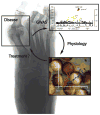ABCG transporters and disease
- PMID: 21554546
- PMCID: PMC4947372
- DOI: 10.1111/j.1742-4658.2011.08171.x
ABCG transporters and disease
Abstract
ATP-binding cassette (ABC) transporters form a large family of transmembrane proteins that facilitate the transport of specific substrates across membranes in an ATP-dependent manner. Transported substrates include lipids, lipopolysaccharides, amino acids, peptides, proteins, inorganic ions, sugars and xenobiotics. Despite this broad array of substrates, the physiological substrate of many ABC transporters has remained elusive. ABC transporters are divided into seven subfamilies, A-G, based on sequence similarity and domain organization. Here we review the role of members of the ABCG subfamily in human disease and how the identification of disease genes helped to determine physiological substrates for specific ABC transporters. We focus on the recent discovery of mutations in ABCG2 causing hyperuricemia and gout, which has led to the identification of urate as a physiological substrate for ABCG2.
© 2011 The Authors Journal compilation © 2011 FEBS.
Figures




Similar articles
-
Identification of a urate transporter, ABCG2, with a common functional polymorphism causing gout.Proc Natl Acad Sci U S A. 2009 Jun 23;106(25):10338-42. doi: 10.1073/pnas.0901249106. Epub 2009 Jun 8. Proc Natl Acad Sci U S A. 2009. PMID: 19506252 Free PMC article.
-
[Urate exporter gene ABCG 2/BCRP and gout risk].Seikagaku. 2011 Dec;83(12):1131-5. Seikagaku. 2011. PMID: 22352045 Review. Japanese. No abstract available.
-
Gout-causing Q141K mutation in ABCG2 leads to instability of the nucleotide-binding domain and can be corrected with small molecules.Proc Natl Acad Sci U S A. 2013 Mar 26;110(13):5223-8. doi: 10.1073/pnas.1214530110. Epub 2013 Mar 14. Proc Natl Acad Sci U S A. 2013. PMID: 23493553 Free PMC article.
-
ABCG transporters: structure, substrate specificities and physiological roles : a brief overview.J Bioenerg Biomembr. 2007 Dec;39(5-6):465-71. doi: 10.1007/s10863-007-9122-x. J Bioenerg Biomembr. 2007. PMID: 17990087 Review.
-
Emerging new paradigms for ABCG transporters.Biochim Biophys Acta. 2009 Jul;1791(7):584-93. doi: 10.1016/j.bbalip.2009.01.007. Epub 2009 Jan 22. Biochim Biophys Acta. 2009. PMID: 19416657 Free PMC article. Review.
Cited by
-
ABCG8 Gene Responses to 8 Weeks Treadmill Running With or Without Pistachia atlantica (Baneh) Extraction in Female Rats.Int J Endocrinol Metab. 2012 Fall;10(4):604-10. doi: 10.5812/ijem.5305. Epub 2012 Sep 30. Int J Endocrinol Metab. 2012. PMID: 23843831 Free PMC article.
-
A comprehensive analysis of the association of common variants of ABCG2 with gout.Sci Rep. 2017 Aug 30;7(1):9988. doi: 10.1038/s41598-017-10196-2. Sci Rep. 2017. PMID: 28855613 Free PMC article.
-
ABCG2 polymorphisms in gout: insights into disease susceptibility and treatment approaches.Pharmgenomics Pers Med. 2017 Apr 20;10:129-142. doi: 10.2147/PGPM.S105854. eCollection 2017. Pharmgenomics Pers Med. 2017. PMID: 28461764 Free PMC article. Review.
-
ABCG2 null alleles define the Jr(a-) blood group phenotype.Nat Genet. 2012 Jan 15;44(2):131-2. doi: 10.1038/ng.1075. Nat Genet. 2012. PMID: 22246507
-
Genome-Wide Identification, Characterization and Phylogenetic Analysis of ATP-Binding Cassette (ABC) Transporter Genes in Common Carp (Cyprinus carpio).PLoS One. 2016 Apr 8;11(4):e0153246. doi: 10.1371/journal.pone.0153246. eCollection 2016. PLoS One. 2016. PMID: 27058731 Free PMC article.
References
-
- Ueda K. Function and regulation of ABCA1. FEBS J. 2011;XX:XXXX. - PubMed
-
- Callaghan R. Translocase ABCA4: seeing is believing. FEBS J. 2011;XX:XXXX. - PubMed
-
- Klucken J, Buchler C, Orso E, Kaminski WE, Porsch-Ozcurumez M, Liebisch G, Kapinsky M, Diederich W, Drobnik W, Dean M, et al. ABCG1 (ABC8), the human homolog of the Drosophila white gene, is a regulator of macrophage cholesterol and phospholipid transport. Proc Natl Acad Sci U S A. 2000;97:817–822. - PMC - PubMed
Publication types
MeSH terms
Substances
Grants and funding
LinkOut - more resources
Full Text Sources
Medical
Molecular Biology Databases

